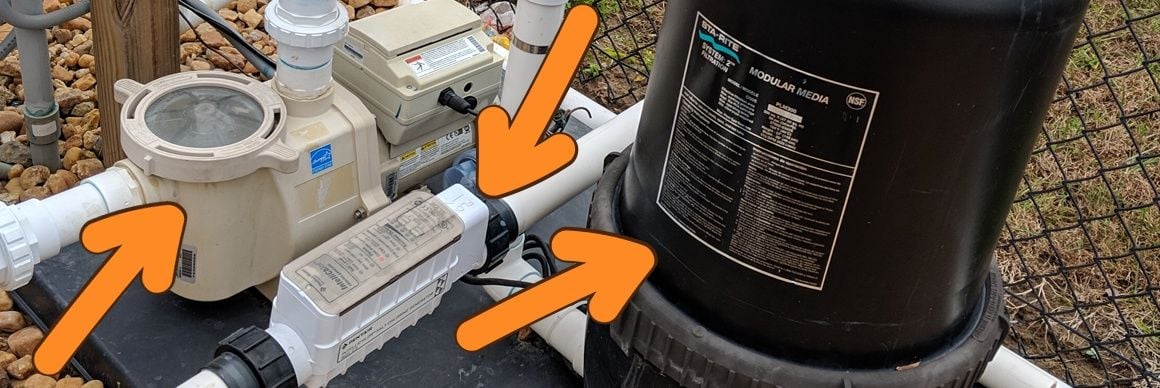
Technology is hard. It's even worse when you can't pick the equipment out of a lineup. But we're here to make your life easier, in every way we can. So today... let's talk filter systems.
Heads up: River Pools specializes in inground fiberglass pools. However, this filter system guide applies to any type of pool.
How Your Filter System Works: The Short Answer
Your pump pulls the pool water from the skimmer(s) on the pool wall and the main drain(s) on or near the bottom of the pool.
The water flows through the pump to the filter, which removes dirt, debris, and (if the filter is capable) bacteria.
After the water is filtered, it flows through the plumbing to the heater (if you have one) and then onto whichever sanitizing component you have.
The filtered, sanitized water returns to the pool through the return jets on the pool walls.
.jpg?width=512&height=288&name=unnamed%20(11).jpg)
-1.jpg?width=512&height=213&name=unnamed%20(12)-1.jpg)
The Skimmer and Main Drain
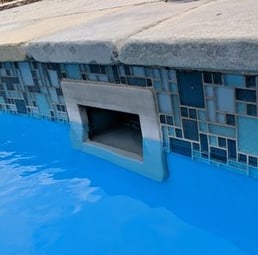
These features are probably already familiar to you, but just to recap.
A skimmer is the rectangular opening at the top of the pool wall, right below the coping. (The water level should generally be about halfway to two-thirds up the skimmer.)
A main drain is the big ol' drain at the bottom of the pool or low on the pool wall in the deep end. They're usually round or square and are installed in pairs to meet national pool safety codes.
Side note: You may not have a main drain—they're becoming less common in residential pools in favor of only skimmers. This is because main drains provide additional water flow to the pump to meet the gallons-per-minute (flow rate) requirement for the size of your pool and the water features incorporated. Because each pool project is different, main drains aren't always necessary.
Water flows through the skimmer and the main drain towards the pool pump and filter to be cleaned.
The Pool Pump
A pool pump consists of three components: a strainer pot, generally a big, round canister at the front, a pump just behind the strainer pot, and a motor in the back.
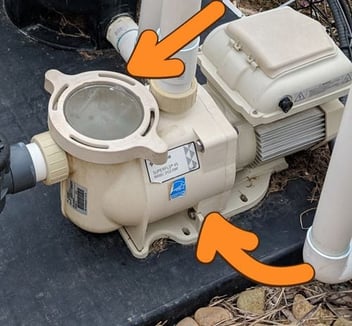
A spinning impeller inside the pump pulls the water in from the pool.
This water hits the first part of the pump, the strainer pot, and then the impeller pushes it onto the filter.
The strainer pot usually has a clear lid so you can assess the water level inside the pump and visibly check for any debris that may be impeding water flow through the system.
The Pool Filter
All pool filters fall into one of these three categories:
- Cartridge filter
- Sand filter
- Diatomaceous earth (D.E.) filter
For decades, the most popular type of filter was the sand filter, but cartridge filters have grown rapidly. It seems today that most owners prefer a cartridge filter with their fiberglass pool.)
A cartridge filter uses cartridges—big sheets of polyester cloth or paper folded accordion-style—to catch debris. Some of these filters only need a single cartridge; others need multiple.
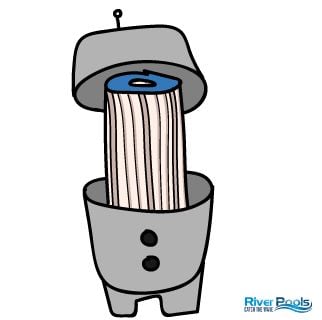
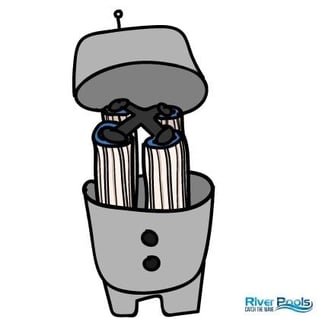
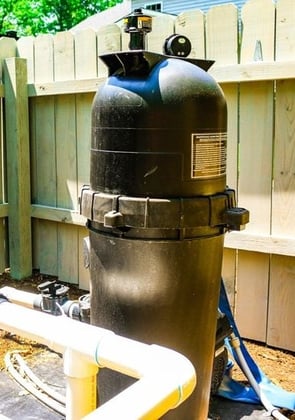
A sand filter is, you guessed it, a tank full of sand. Slotted lateral pipes at the bottom disperse water evenly through the sand to catch debris.
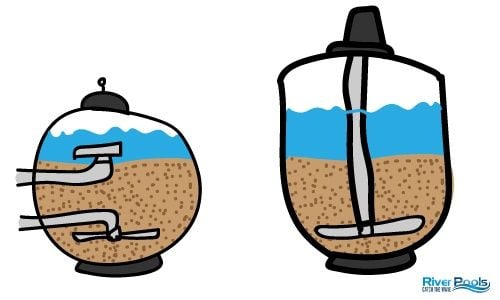
D.E. filters use 8–10 filter grids/fingers covered in D.E. powder (diatomaceous earth, which is basically fossil dust) to catch debris. The fingers may look like hanging stalactites or overlapping curved shutters, depending on the model.
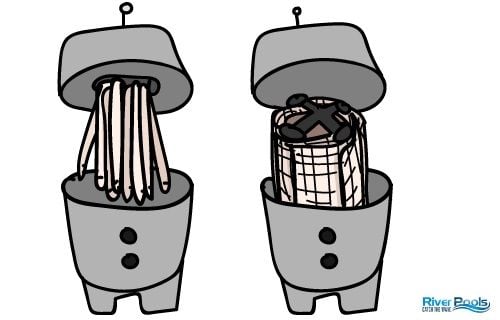
A quick note about filter quality!
Dirt and debris are measured in microns, which is short for micrometer—one-millionth of a meter. Yes, that's a lot of zeros.
For reference:
- 1 millimeter: 1,000 microns
- Human hair: 50–100 microns
- Pollen: 30 microns
- Household dust: 4 microns
- Bacteria: 2 microns
A filter's "micron level" tells you the size of the smallest debris it catches, so a lower micron level means better filtration.
The Pool Heater
Pretty much all pool heaters are one of these three types:
- Electric heat pumps
- Solar heaters
- Natural gas/propane heaters
Solar heaters usually look like solar panels and are outside the scope of basic pump/filter system plumbing. For our purposes today, we're talking heat pumps and natural gas/propane heaters.
A pool heater tends to look big and clunky. Fair enough; it has a lot of work to do.
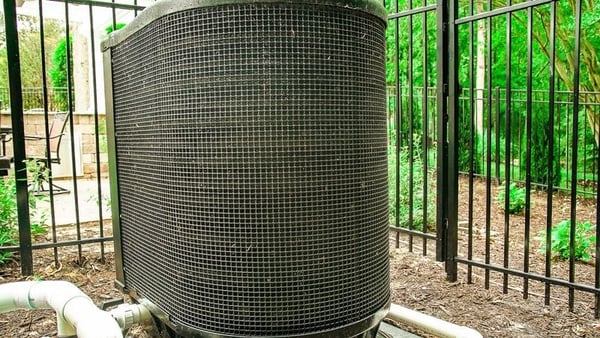
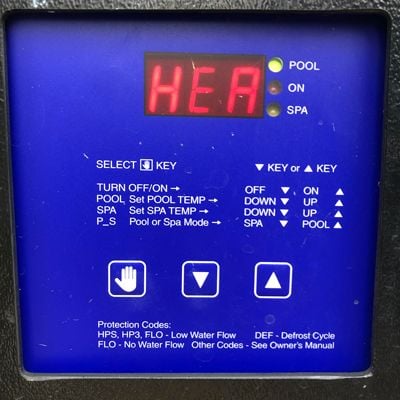
You can choose to get a heat pump with a chiller feature. That's especially awesome if you live in a toasty climate, have a shallow pool, or use an automatic pool cover (which can absorb a lot of heat from the sun).
Fun fact: Many customers who install heaters choose gas heaters because they work in all climates and can heat the pool faster. Heat pumps are popular because of their dependability and low operating cost, although they do not work in lower temperatures.
The Pool Sanitizing Component - 3 Common Options
Your skimmer, strainer pot, and filter remove dirt and debris, but what about bacteria, algae, and other contaminants? That’s where your pool’s sanitizing component comes in. After the water is filtered, it flows through one (or more) sanitizing systems before returning to the pool.
Here are three of the most common ways to sanitize your pool water:
1. Traditional Chlorinators
A traditional chlorine system relies on manually adding chlorine in tablet, liquid, or granular form. Many pool owners use chlorinators, which are small canisters installed in the plumbing that slowly dissolve chlorine tablets as water passes through. This provides consistent chlorine levels with less frequent manual dosing.
Chlorine is effective at killing bacteria, viruses, and algae, but it requires regular monitoring to maintain the proper chemical balance and avoid issues like chloramine buildup (which causes the classic "pool smell").
*We recommend using only liquid chlorine for fiberglass pools.
2. UV Pool Sanitizers
Ultraviolet (UV) sanitizers work alongside a chlorine system to reduce the amount of chlorine needed. These systems use a UV light chamber to destroy bacteria, viruses, and algae spores as water passes through.
While UV sanitizers don’t replace chlorine entirely, they significantly cut down on chemical usage and help reduce chloramines, which can improve water clarity and comfort.
3. Salt Chlorine Generators
A salt chlorine generator (often called a salt system) creates chlorine from salt. Instead of manually adding chlorine to the pool, you add salt to the water, and the system converts it into chlorine using an electrolysis process inside a salt cell.
The result? A steady, self-regulating chlorine supply that keeps your pool sanitized with fewer fluctuations. And no, a saltwater pool isn’t as salty as the ocean—it’s about as salty as a teardrop.
Salt chlorine generators are popular because they reduce the need for storing and handling chlorine while making the water feel smoother on the skin. However, they still require monitoring to ensure the salt levels and chlorine output stay balanced.
*Salt chlorine generators are available in various sizes and with various output capabilities. Be certain to choose a generator that matches the volume of your pool to avoid overproducing chlorine, which could destroy the pool's surface.
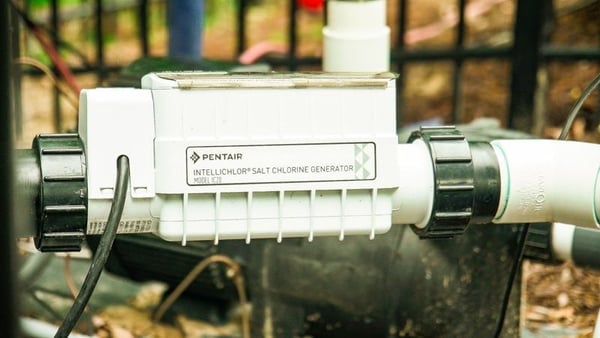
The Return Jets
Return jets... well, they return the filtered water to the pool.
Spa jets are a variant of this.
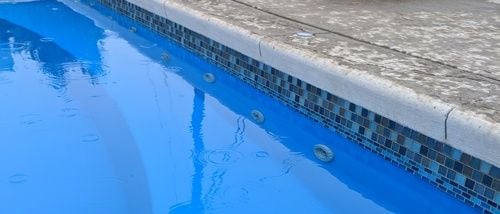
I'm trying to think of a way to make it more complicated, but it's not.
Pop quiz!
Let's see if you can pick out the 3 major parts of your filter system: the pump, the filter, and the sanitizing component.
(It's an open-book quiz. We included arrows.)
Recognize them here?
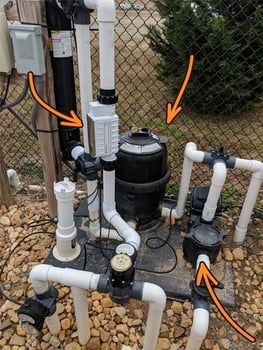
How about in this configuration?
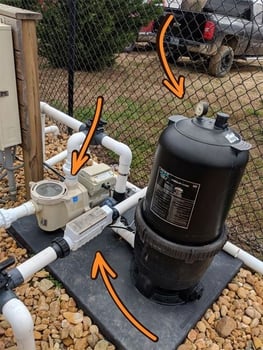
What about this "mysterious" fourth feature? It sure does turn up the heat on the challenge...
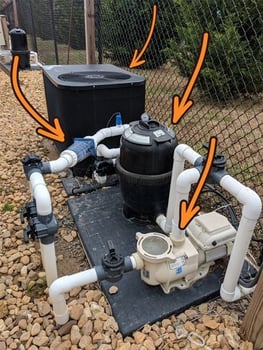
Honestly, it just feels cool to be able to look at a mess of plumbing equipment and say, "Ah yes, there is the filter! And there is the pump! I know so much about pools. Ohoho!" (That last bit is where you chortle like a baron.)
Want to learn more about pools?
I mean, you're basically a pool pro now. But it never hurts to expand your repertoire!
Our blog articles and our YouTube channel videos answer every question you may have about pools, throughout both the buying process and lifetime ownership. Check them out, and then impress your friends and family with your pool knowledge!
River Pools specializes in inground fiberglass pools. We are firm believers in their long-term quality—they're beautiful and durable, require lower maintenance, and have a quicker installation time to boot.
Up Next:
Where Should I Locate My Pool Filter System?
Inground Saltwater Pool Cost: Salt, Cells, Generators, and More
Editor's note: This article was originally written by Holly Jender and was updated on December 18, 2024, with current information. River Pools is a brand of inground fiberglass pools produced in a manufacturing facility in Fortville, IN. While our expertise is in manufacturing fiberglass pools, we have access to a network of installers with expertise relating to project design, installation, and pool service. We often tap into this knowledge base and share information freely with homeowners, just like you, considering installing a swimming pool in your backyard.

